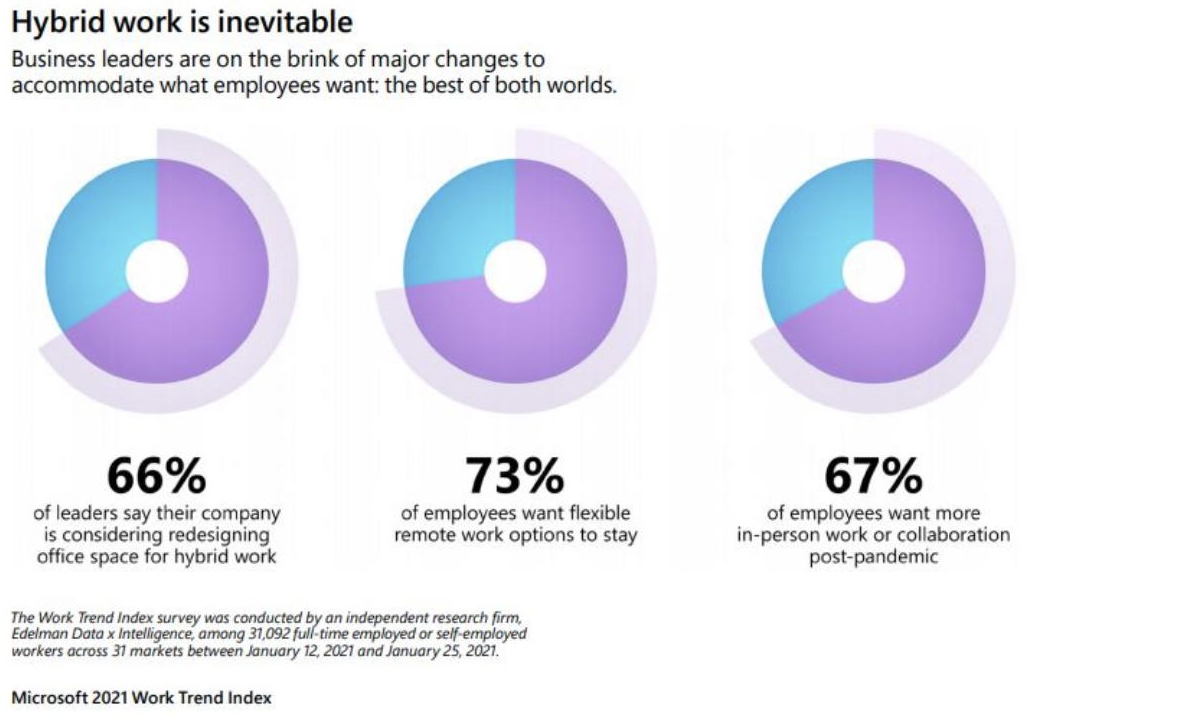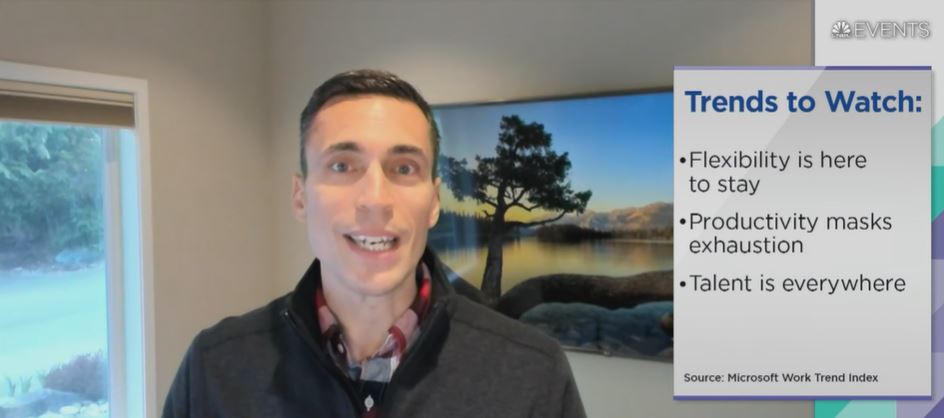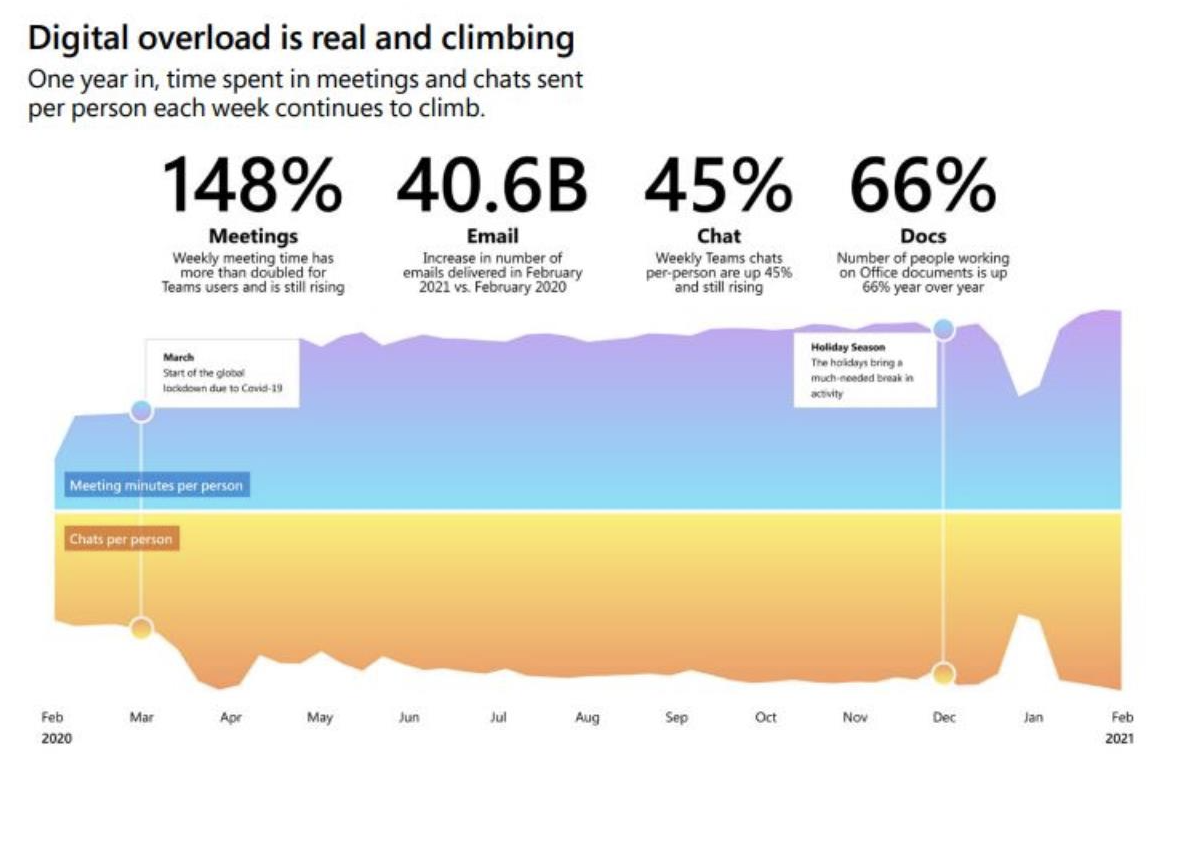Work Today Sucks — and Microsoft Just Proved It
Microsoft just completed its “2021 Work Trend Index: Annual Report.” And parts of it are frightening.
While the world debates the future of work after the pandemic, this Microsoft report mainly zeroes in on the state of work today. This survey was conducted by among 31,092 full-time employed or self-employed workers across 31 markets between Jan. 12, 2021 to Jan. 25, 2021. At least 1,000 full-time workers were surveyed in each market — and each market was sampled to be representative of the full-time workforce across age, gender, and region across a mix of work environments (remote vs. non-remote, office settings vs. non-office settings, etc.), industries, company sizes, tenures and job levels.
Usually reports from big high-tech companies are not scary, but then we’ve never before seen reports issued in the middle of a pandemic.
Microsoft calls this year’s annual report “The Next Great Disruption Is Hybrid Work – Are We Ready?” And proceeds to answer their own question: No way.
Microsoft’s report contends hybrid work is here to stay. Sure, the Seattle blue badges have a lot to gain by proving that. But their data only echoes other research. Most employees want it both ways: “I want to work from home when I want and I want come into an office when I want.”
We all know that “I-wants” don’t get.
Most companies are prepared to accept some hybrid work as a permanent change — and a minority embrace remote work as the main workplace as they imagine all real estate costs will soon be dropping from their traditional place on the ledger to the profit line.

Most bosses won’t be comfortable letting the staff decide. Nothing new in that attitude.
“This event has the same impact on workers as a world war or major global event on their psyche. This causes people to be more thoughtful about their lives. They are resetting. Doing the things most important to them,” Jared Spataro, Corp. VP at Microsoft 365, speaking on CNBC.

The first scary observation: Microsoft’s report reveals business leaders are out of touch with employees and don’t realize it. High productivity is masking what’s really going on. Microsoft goes so far as to say bosses need “a wake-up call.”
Most business leaders have no clue of what’s coming.
Here is scary observation #2: Employees feel overworked and underappreciated.
Nearly one in five global survey respondents say their employer doesn’t care about their work-life balance. Fifty-four percent feel overworked. Thirty-nine percent feel exhausted.
And trillions of productivity signals from Microsoft 365 quantify the precise digital exhaustion workers are feeling. The digital intensity of workers’ days has increased substantially, the average number of meetings and chats steadily rising since last year.
You’ve heard about “Zoom Fatigue,” but when Microsoft compares collaboration trends in Microsoft 365 between February 2020 and February 2021 they saw:
- Time spent in Microsoft Teams meetings has more than doubled (2.5x) globally and, aside from a holiday dip in December, continues to climb.
- The average Teams meeting is 10 minutes longer, up from 35 to 45 minutes year-over-year.
- The average Teams user is sending 45% more chats per week and 42% more chats per person after hours, with chats per week still on the rise.
- The number of emails delivered to commercial and education customers in February, when compared to the same month last year, is up by 40.6 billion.
- There was a 66% increase in the number of people working on documents.

This barrage of communications is unstructured and mostly unplanned, with 62% percent of Teams calls and meetings unscheduled or conducted ad hoc. And workers feel the pressure to keep up: Despite meeting and chat overload, 50% of people respond to Teams chats within five minutes or less, a response time that has not changed year-over-year. This proves that the intensity of our workday, and what is expected of employees during this time, has increased significantly.
“Work and life have blurred in new ways. The workday has elongated by at least an hour, and some countries by two,” notes Spataro. “People do more work after hours and more work on weekends. People don’t know how to navigate without natural breaks like commuting. We’re going to have to learn.”
And now we have scary observation #3: What are workers going to do about it?
41% of employees are considering leaving their current employer this year. This year! And 46% say they’re likely to move because they can now work remotely.
Most companies couldn’t deal with 10% of their workforce leaving in the same year and the second largest impact of a mass exodus would be higher costs to retain employees or higher cost to train new employees. The first largest impact is all that company know-how is walking out the door …
Now scary point #4: The staff says teams are now more siloed than before.
Collaboration trends in Microsoft Teams and Outlook confirm that interactions with our immediate team, or close networks, increased with the move to remote work but our interactions outside of that team, or distant networks, have diminished. And that spells less innovation, less overall corporate collaboration. And it means bosses will want to drag workers back into offices.
There is still more bad news. Microsoft’s report says Gen Z is Z’d out. Sixty percent say they are struggling or merely surviving.
Survey respondents reported Gen Z are more likely to struggle balancing work with life (+8 percentage points) and to feel exhausted after a typical day of work (+8 percentage points) when compared to older generations.
Gen Z also reported more difficulty feeling engaged or excited about work, getting a word in during meetings, and bringing new ideas to the table when compared to other generations.
“Our findings have shown that for Gen Z and people just starting in their careers, this has been a very disruptive time,” says LinkedIn Senior Editor-at-Large George Anders in this Microsoft report. “It’s very hard to find their footing since they’re not experiencing the in-person onboarding, networking, and training that they would have expected in a normal year.”
We could be stunting the next generation of workers.
Work today sucks — Microsoft research shows workers are feeling overworked and stressed, contemplating leaving for new companies while bosses think their business is coasting along the pandemic highway. Gen Z is lost and no one is looking for them. Teams are rowing well in the same boat but cut off from the resources of the Mother Ship.
And in EMEA, when compared to the global average, workers are…
- Trending toward more burnout: on a typical workday, 42% of workers in EMEA feel exhausted (versus the 39% global average) and 46 percent feel stressed (versus the 42% global average).
- More settled in their current location: only 36% of remote workers in EMEA are likely to move to a new location because they can work remotely (versus the 46% global average).
- Feel less freedom to be their authentic selves: 30% of remote workers in EMEA say they are more likely to be their authentic selves at work compared to last year (versus the 44% global average).
Where is the good news? Microsoft talks about authenticity in the workplace, about what percent was comfortable crying in front of their co-workers. The authors see authenticity as an antidote to isolation. Some of us see it as a symptom of the isolation and the traversing of work/life balance.
It might be a cheerful note to hear you can find talent anywhere in a hybrid world. Yet those might be your own former employees who moved to Fiji because now they can.
Seven Urgent Trends Microsoft Says Every Business Leader Needs to Know in 2021
- Flexible work is here to stay.
- Leaders are out of touch with employees and need a wake-up call.
- High productivity is masking an exhausted workforce.
- Gen Z is at risk and will need to be reenergized.
- Shrinking networks are endangering innovation.
- Authenticity will spur productivity and well-being.
- Talent is everywhere in a hybrid work world.



